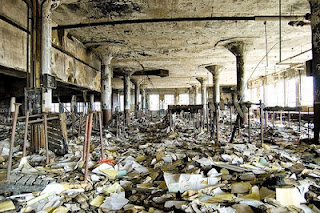Wednesday, June 13, 2012
Requiem for Detroit?
Requiem for Detroit? will screen Thursday, June 14 and Sunday, June 17 at Anthology Film Archives's "Sometimes Cities: Urban America Beyond NYC"
As this post on Changing Gears notes, “we seem to hear every week about a new documentary film being made about Detroit”—-and they all tell pretty much the same sad-with-a-dash-of-hope story. Julien Temple’s 2010 addition to the roll call, Requiem for Detroit?, earns a D for originality, but I’d give it a B for presentation.
Temple hits all the usual high points: the lingering shots of ruin porn; the voiceover narration presenting the city’s history as a Golden Arches-sized arc; the corny archival footage from the glory days and the ominous-music-backed clips from its decline; and the defiantly hopeful coda about community gardens springing up on abandoned lots. But, as you might expect from a director who specializes in making movies about musicians, he rounds up an interesting bunch of artists as his talking heads. Even when they’re saying the same old same old, they deliver it with a little style and city-rat savoir faire, and every so often they say something new.
Lowell Boileau, an artist who talks to the unseen interviewer in his passenger seat while cruising through the city’s half-deserted streets, describes Detroit as a city of islands, some of them perfectly safe, others not so much so. “The crime rate, yeah, it’s high,” he says, “but it’s only high when it happens to you.”
Community activist Grace Lee Boggs, who was about 95 when she talked to Temple, wears her wisdom as lightly as her years, talking at least as enthusiastically about the young urban pioneers of the present as she does about the comrades of her youth. It’s nice to see Mitch Ryder and Martha Reeves, too, their mere presence a kind of benediction even if they don’t say anything particularly memorable.
Temple finds a few interesting pieces of archival footage, like a shot of a young and surprisingly graceful Henry Ford almost dancing on ice skates. He also adds resonance to some more prosaic images by projecting them onto abandoned buildings at night, making them function as ghostly reminders of the bustling past buried under the derelict present.
And if he relies too much on imagery of cars, including more than one shot of a test car crashing into a wall to symbolize the city’s economic collapse, even that cliché provides at least one interesting shard of insight into the city’s DNA. “They set it up so you have to have a car,” says one of his subjects of the city’s designers. “They create the illusion that you want one; the reality is that you need it.”
Written for The L Magazine
Subscribe to:
Post Comments (Atom)

No comments:
Post a Comment